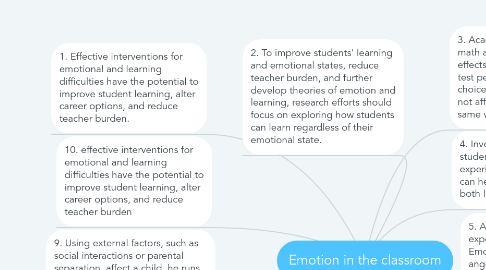Emotion in the classroom
by Gustavo Gonzalez

1. 1. Effective interventions for emotional and learning difficulties have the potential to improve student learning, alter career options, and reduce teacher burden.
2. 2. To improve students' learning and emotional states, reduce teacher burden, and further develop theories of emotion and learning, research efforts should focus on exploring how students can learn regardless of their emotional state.
3. 8. If emotional states are the result of classroom factors, such as content difficulty, adapting learning contexts can be helpful in enhancing both learning and negative emotions.
4. 9. Using external factors, such as social interactions or parental separation, affect a child, he runs the risk of being left behind. While schools have limited ability to change the emotional reaction of students in such circumstances, they may be able to minimize the educational impact.
5. 10. effective interventions for emotional and learning difficulties have the potential to improve student learning, alter career options, and reduce teacher burden
6. 3. Academic anxieties, such as math anxiety, have wide-ranging effects that affect strategy use, test performance, and subject choice. However, anxiety does not affect all students in the same way.
7. 4. Investigating how some students can learn despite experiencing negative emotions can help to better understand both learning and emotions.
8. 5. Anxiety is not the only emotion experienced in the classroom. Emotions such as enjoyment, anger, hope, pride, and boredom can affect students and learning in a number of ways
9. 6. Given the number of students, the variety of emotions and their causes, teachers cannot be expected to handle all of these experiences effectively.
10. 7. We need to know if emotions affect only test / assessment performance, or if they extend to affect student knowledge and skill development.


